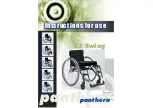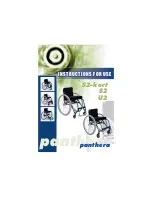
932208 Rev. A
X . B a t t e r i e s
43
X . B a t t e r i e s
932208 Rev. A
42
D. CONNECTING BATTERIES IN BATTERY COMPARTMENT
1. Batteries weigh up to 55 lbs. (25 kg). Take care to avoid injury when lifting.
2. Keep batteries upright. Take care not to spill acid (wet cell batteries).
3. Always wear rubber gloves and safety glasses when you handle batteries.
4. Before working around batteries, remove all metal personal effects, such as
necklaces, rings, watches, pins and other metal jewelry that might contact
battery terminal and cause a short.
1. Lift batteries into battery compartment.
Batteries weigh up to 55 pounds (25 kg). Lifting batteries may cause back
strain. If you fail to heed these warnings severe injury may occur to you.
2. Connect and disconnect battery cables with caution. Connect the red lead to
the positive terminal and the black lead to the negative terminal. Do this for
each battery.
3. Tighten all terminal fasteners using two 1/2" box end wrenches to 60 in-lbs
(6.8 N.m).
4. Place the battery compartment lid on power base and secure using the two (2)
quarter turn fasteners (push down on fasteners).
PROHIBITED!
Never make direct contact across both battery terminals, as an explosion
may occur. A spark may result in an explosion and/or fire resulting in severe
injury or death.
E. CHARGING BATTERIES
To avoid the risk of severe injury or death from electrical shock, fire or
explosion while charging:
PROHIBITED!
Never
connect charger to a 240 volt source. The main input voltage is 110 volts.
Never touch the charger after it is connected to an electrical outlet. This may
cause electrical shock.
•
Never
connect or disconnect charger from battery while there is power to
the charger.
1.
Never
use an extension cord. Use of an improper cord could damage the charger
or cause a fire or electrical shock.
2. A battery emits explosive hydrogen gas during charging. To reduce the risk of
2. Caution — To Avoid Damage to the Charger:
• Never place the charger on top of a battery during charging. (Gases from the
battery can damage the charger and may lead to an explosion or fire).
• Never place a battery on top of the charger.
• Never expose charger to rain or snow.
• Never unplug charger by pulling on the electrical cord. This will damage the
cord.
• Never open a charger or attempt to repair it yourself. Return charger to Sunrise
or have repairs made only by a qualified person.
• Keep cord out of the way, where it will not be stepped on, tripped over,
or damaged.
3. Caution — To Avoid Damage to the Battery:
• Make sure you use the correct setting for sealed (gel) batteries (located on the
off-board charger).
• Never charge a frozen battery. A fully charged battery will rarely freeze, but the
fluid in a discharged battery can freeze at 16 degrees Fahrenheit (minus 9
degrees Centigrade). If you suspect a battery is frozen, thaw it before charging.
Lead acid batteries generate explosive gas while charging. Completely read
and follow all warnings about the batteries in this user instruction manual
and any labels applied to the product. Failure to do so could result in fire,
explosion, injury and/or death.
C. ACID BURNS (UNSEALED WET CELL BATTERIES)
Acid in batteries is corrosive. It can cause serious burns to the eyes and skin and can
damage floors, furniture, clothing and your wheelchair.
1. Use extreme care not to spill acid when you handle batteries.
Keep batteries upright.
2. Avoid contact of acid with bare skin or clothing.
3. Always wear rubber gloves and safety glasses when you handle batteries.
4. If acid contacts your skin or clothing, wash immediately with soap and water.
5. If acid contacts your eyes, immediately flood eyes with cold running water
for at least 15 minutes. Seek medical attention immediately.





































